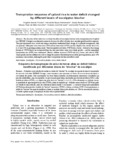Use este identificador para citar ou linkar para este item:
http://www.alice.cnptia.embrapa.br/alice/handle/doc/927378Registro completo de metadados
| Campo DC | Valor | Idioma |
|---|---|---|
| dc.contributor.author | PEREIRA, R. G. | pt_BR |
| dc.contributor.author | HEINEMANN, A. B. | pt_BR |
| dc.contributor.author | MADARI, B. E. | pt_BR |
| dc.contributor.author | CARVALHO, M. T. de M. | pt_BR |
| dc.contributor.author | KLIEMANN, H. J. | pt_BR |
| dc.contributor.author | SANTOS, A. P. dos | pt_BR |
| dc.date.accessioned | 2012-06-29T11:11:11Z | pt_BR |
| dc.date.available | 2012-06-29T11:11:11Z | pt_BR |
| dc.date.created | 2012-06-29 | pt_BR |
| dc.date.issued | 2012 | pt_BR |
| dc.identifier.citation | Pesquisa Agropecuária Brasileira, v. 47, n. 5, p. 716-721, maio 2012. | pt_BR |
| dc.identifier.uri | http://www.alice.cnptia.embrapa.br/alice/handle/doc/927378 | pt_BR |
| dc.description | The objective of this work was to evaluate the effect of eucalyptus biochar on the transpiration rate of upland rice 'BRSMG Curinga' as an alternative means to decrease the effect of water stress on plant growth and development. Two-pot experiments were carried out using a completely randomized block design, in a split-plot arrangement, with six replicates. Main plots were water stress (WS) and no-water stress (NWS), and the subplots were biochar doses at 0, 6, 12 and 24% in growing medium (sand). Total transpirable soil water (TTSW), the p factor - defined as the average fraction of TTSW which can be depleted from the root zone before water stress limits growth-, and the normalized transpiration rate (NTR) were determined. Biochar addition increased TTSW and the p factor, and reduced NTR. Consequently, biochar addition was able to change the moisture threshold (p factor) of the growing medium, up to 12% maximum concentration, delaying the point where transpiration declines and affects yield. | pt_BR |
| dc.language.iso | eng | eng |
| dc.rights | openAccess | eng |
| dc.subject | Estresse abiótico | pt_BR |
| dc.title | Transpiration response of upland rice to water deficit changed by different levels of eucalyptus biochar. | pt_BR |
| dc.type | Artigo de periódico | pt_BR |
| dc.date.updated | 2019-02-19T11:11:11Z | pt_BR |
| dc.subject.thesagro | Arroz | pt_BR |
| dc.subject.thesagro | Oryza sativa | pt_BR |
| dc.subject.thesagro | Eucalipto | pt_BR |
| dc.subject.thesagro | Deficiência hídrica | pt_BR |
| dc.subject.nalthesaurus | biochar | pt_BR |
| riaa.ainfo.id | 927378 | pt_BR |
| riaa.ainfo.lastupdate | 2019-02-19 -03:00:00 | pt_BR |
| dc.identifier.doi | https://doi.org/10.1590/S0100-204X2012000500012 | eng |
| dc.contributor.institution | ROGÉRIO GOMES PEREIRA, UNIVERSIDADE FEDERAL DE GOIÁS | pt_BR |
| dc.contributor.institution | ALEXANDRE BRYAN HEINEMANN, CNPAF | eng |
| dc.contributor.institution | BEATA EMOKE MADARI, CNPAF | eng |
| dc.contributor.institution | MARCIA THAIS DE MELO CARVALHO, CNPAF | eng |
| dc.contributor.institution | HUBERTO JOSE KLIEMANN, UNIVERSIDADE FEDERAL DE GOIÁS | eng |
| dc.contributor.institution | AURÉLIO PEREIRA DOS SANTOS, CNPAF. | eng |
| Aparece nas coleções: | Artigo em periódico indexado (CNPAF)  | |
Arquivos associados a este item:
| Arquivo | Descrição | Tamanho | Formato | |
|---|---|---|---|---|
| a12v47n5.pdf | 653,8 kB | Adobe PDF |  Visualizar/Abrir |









